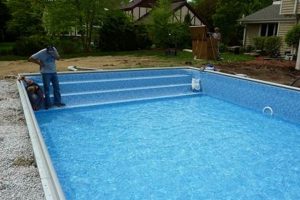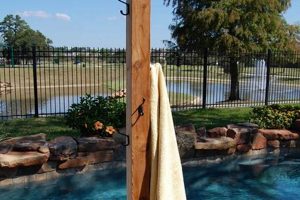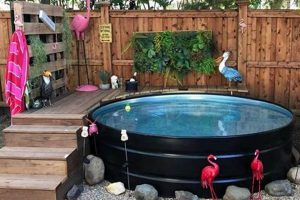A self-installed barrier designed to restrict unsupervised access to a swimming pool area is a crucial safety measure for households with children or pets. These systems typically involve modular fencing panels, self-closing gates, and ground sleeves for secure installation. Examples range from mesh fences to more robust metal or composite structures.
The establishment of a physical barrier around a pool significantly reduces the risk of accidental drowning, a leading cause of injury and death for young children. The implementation of such systems can offer peace of mind to homeowners, and in many jurisdictions, adherence to pool safety regulations is legally mandated. The concept of pool barriers has evolved over time, with advancements in materials and design focusing on enhanced durability and ease of installation.
The following sections will address considerations for selecting appropriate materials, installation techniques, and adherence to local building codes relevant to creating a safe and effective pool enclosure.
Installation Guidance
The successful creation of a secure pool environment requires careful planning and diligent execution. The following points provide essential guidance for a project focused on independent construction.
Tip 1: Comprehensive Planning: Prior to any physical work, a detailed plan outlining the fence’s perimeter, gate locations, and anchoring points is essential. Accurate measurements and consideration of the surrounding landscape are critical.
Tip 2: Code Compliance Verification: Researching and understanding local building codes and regulations regarding pool fencing is paramount. Compliance ensures safety and avoids potential legal issues. Confirm height requirements, gate specifications, and any required inspections.
Tip 3: Material Selection: Choose durable, weather-resistant materials suited to the local climate. Consider factors such as UV resistance, rust prevention, and overall strength. Options include aluminum, steel, and reinforced mesh.
Tip 4: Proper Anchoring: Secure anchoring is crucial for fence stability. Follow manufacturer instructions precisely for setting ground sleeves or posts in concrete. Ensure adequate depth and proper curing of concrete.
Tip 5: Gate Functionality: The self-closing and self-latching mechanisms of the gate are vital safety features. Test the gate frequently to ensure proper operation and make adjustments as needed. Latch height must meet code requirements.
Tip 6: Consistent Inspection: Regular inspection of the entire structure is necessary to identify and address any signs of damage or wear. Prompt repairs will maintain the fence’s integrity and effectiveness.
Tip 7: Professional Consultation: While the project is intended to be independent, seeking advice from a qualified professional, such as a fence installer or building inspector, can address complex situations or concerns regarding compliance.
Adherence to these recommendations promotes the creation of a robust and reliable safety barrier, providing enhanced protection against accidental access to the pool area.
The subsequent section will address common challenges encountered during the project and provide potential solutions.
1. Code Compliance
Adherence to local regulations is paramount when undertaking the independent construction of a pool barrier. These codes are established to minimize the risk of accidental drowning and ensure a minimum standard of safety for pool users, particularly children. Disregarding these regulations can lead to legal repercussions, financial penalties, and, more importantly, compromised safety.
- Height Requirements
Most jurisdictions mandate a minimum fence height, typically four feet or higher, to prevent young children from climbing over the barrier. This height requirement is often specified in detail, indicating acceptable materials, construction methods, and allowances for ground clearance. Non-compliance can result in mandated alterations and legal liabilities.
- Gate Specifications
Regulations often dictate precise requirements for gate construction, including self-closing and self-latching mechanisms. Gate latches must be positioned at a height inaccessible to young children, and the gate must swing outward, away from the pool area. Failure to meet these specifications can render the entire barrier ineffective.
- Permitting and Inspections
Many municipalities require homeowners to obtain a permit prior to constructing a pool barrier. This process often involves submitting detailed plans for review and undergoing inspections at various stages of construction. Inspections ensure adherence to code requirements and provide an opportunity to address any deficiencies before the project is completed. Bypassing the permitting process can lead to fines and mandatory removal of non-compliant structures.
- Barrier Integrity
Local codes frequently specify requirements for the structural integrity of the barrier. This includes limitations on gaps or openings within the fence, restrictions on climbing aids near the fence, and regulations regarding the proximity of the barrier to other structures or objects. The goal is to create a continuous, impenetrable barrier that effectively restricts access to the pool area.
These facets of regulatory compliance are inextricably linked to the successful and safe independent construction of a swimming pool barrier. Prioritizing thorough research of local codes, meticulous planning, and adherence to established guidelines is essential for safeguarding pool users and mitigating potential liabilities. The absence of such considerations significantly elevates the risk of accidents and legal consequences.
2. Material Durability
The longevity and effectiveness of a self-installed pool barrier are directly contingent upon the inherent durability of the selected materials. The pool environment, characterized by exposure to moisture, chemicals, and varying weather conditions, necessitates the use of robust materials capable of withstanding degradation over extended periods.
- Corrosion Resistance
Materials used in constructing a pool barrier must exhibit exceptional resistance to corrosion. Constant exposure to chlorinated water and humidity can accelerate the degradation of susceptible metals. For instance, aluminum, often used in fencing, requires specialized coatings or alloys to prevent pitting and weakening. Steel, if chosen, demands galvanization or powder coating to impede rust formation. Premature corrosion compromises the structural integrity of the fence, reducing its effectiveness as a safety barrier.
- UV Degradation Resistance
Prolonged exposure to ultraviolet (UV) radiation can cause significant damage to certain materials, particularly plastics and some composite materials. UV degradation leads to discoloration, embrittlement, and a reduction in tensile strength. Mesh fencing, for example, requires UV-resistant coatings or additives to prevent premature failure. Failure to address UV degradation can necessitate frequent replacements, increasing long-term costs and potentially compromising pool safety.
- Impact Resistance
The ability to withstand impact from external forces, such as falling branches, accidental collisions, or deliberate tampering, is a critical aspect of material durability. Brittle materials are prone to cracking or shattering upon impact, creating vulnerabilities in the barrier. Choosing materials with high impact resistance, such as reinforced polymers or heavy-gauge metals, enhances the fence’s ability to maintain its integrity under duress. This consideration is particularly relevant in areas prone to severe weather events or vandalism.
- Chemical Resistance
Pool chemicals, including chlorine, bromine, and algaecides, can have a detrimental effect on certain materials. Prolonged exposure can cause discoloration, softening, or even dissolution. Selecting materials that are chemically inert and resistant to the specific chemicals used in pool maintenance is essential for preserving the fence’s structural integrity and aesthetic appearance. Failure to consider chemical resistance can lead to premature deterioration and the need for costly repairs or replacements.
The selection of durable materials, therefore, constitutes a foundational element in the successful implementation of a safe and long-lasting pool barrier. The specific material choices must align with the prevailing environmental conditions, anticipated stresses, and intended lifespan of the structure. The integration of durable materials is an investment in the prolonged effectiveness of the safety measure and a crucial consideration for any independent construction endeavor.
3. Secure Anchoring
The stability and effectiveness of a self-installed pool barrier are inextricably linked to the integrity of its anchoring system. Without secure anchoring, even the most robust fencing materials become ineffective, potentially compromising the safety of the pool area and rendering the barrier non-compliant with local regulations.
- Foundation Stability
Anchoring points serve as the foundational elements that transfer the load of the fence to the ground. The strength and depth of these anchors directly determine the fence’s ability to resist external forces, such as wind, impact, or attempted removal. Examples include concrete footings, ground sleeves embedded in concrete, or specialized anchoring systems designed for specific soil conditions. Insufficient foundation stability can lead to leaning, displacement, or complete failure of the fence.
- Post Integrity
The method of attaching fence posts to the anchoring system is crucial for maintaining the structural integrity of the entire barrier. Secure connections prevent posts from becoming loose or detached, which can create gaps in the fence or weaken its overall strength. Examples include using high-strength bolts, welding connections, or employing interlocking systems that distribute stress evenly. Compromised post integrity undermines the barrier’s ability to effectively restrict access to the pool area.
- Ground Condition Adaptation
Different soil types and ground conditions require tailored anchoring solutions. Sandy soils, for example, require deeper and wider footings compared to clay soils. Rocky terrain may necessitate the use of specialized drilling techniques or alternative anchoring methods. Failure to adapt the anchoring system to the specific ground conditions can result in instability and premature failure. Accurate assessment of soil conditions and selection of appropriate anchoring methods are essential for a durable and effective pool barrier.
- Resistance to Uplift
In regions prone to high winds or flooding, resistance to uplift forces is a critical consideration. Anchoring systems must be designed to withstand the upward pull exerted by wind or water, preventing the fence from being lifted out of the ground. Examples include using deeper footings, wider anchoring bases, or specialized anchoring devices designed to resist uplift. Insufficient resistance to uplift can lead to catastrophic failure of the fence, particularly during severe weather events.
These interconnected facets underscore the critical role of secure anchoring in ensuring the safety and effectiveness of a self-installed pool barrier. Proper anchoring provides the necessary foundation for a stable and robust fence, capable of withstanding external forces and effectively restricting access to the pool area. Conversely, inadequate anchoring compromises the entire system, potentially negating the intended safety benefits and creating significant liability concerns.
4. Gate Reliability
Within the context of self-constructed pool barriers, gate reliability is a paramount safety consideration. The gate, serving as the access point through the barrier, represents a critical vulnerability if its functionality is compromised. A malfunctioning gate negates the entire purpose of the surrounding fence, rendering the pool area accessible to unsupervised individuals, particularly children. The self-closing and self-latching mechanisms are the cornerstone of gate reliability. If these mechanisms fail, the gate may remain ajar, providing unintended access. Real-life instances of drowning incidents often reveal compromised gate functionality as a contributing factor, highlighting the grave consequences of neglecting this element.
Ensuring gate reliability extends beyond initial installation. Consistent inspection and maintenance are essential for sustained functionality. Hinges require periodic lubrication to ensure smooth operation, and latch mechanisms must be regularly tested to verify secure engagement. Adjustments may be necessary over time to compensate for wear and tear or environmental factors such as ground settling. The selection of high-quality, durable hardware is also critical for minimizing maintenance requirements and maximizing the lifespan of the gate components. Furthermore, adherence to manufacturer specifications during installation ensures optimal performance and reduces the likelihood of premature failure.
In summary, gate reliability is an indispensable component of a functional and effective self-installed pool barrier. Its absence diminishes the overall safety provided by the enclosure. Proactive measures, including careful installation, consistent maintenance, and the selection of robust hardware, are crucial for mitigating the risks associated with gate malfunction and ensuring the sustained protection of the pool area. Overlooking these considerations represents a significant oversight with potentially devastating consequences.
5. Consistent Inspection
The sustained effectiveness of any independently constructed pool barrier hinges upon a program of consistent inspection. Regular evaluation of the system identifies vulnerabilities arising from environmental factors, wear and tear, or unforeseen incidents, thereby preserving the barrier’s protective function.
- Structural Integrity Assessment
Periodic examination of the fence framework, including posts, panels, and connection points, reveals signs of damage such as rust, corrosion, cracks, or loose fittings. Addressing these issues promptly prevents further degradation and maintains the fence’s ability to withstand external forces. Ignoring these early indicators can lead to structural failure, compromising the barrier’s overall integrity. For example, a corroded fence post may weaken over time and eventually break, creating an opening in the barrier.
- Gate Functionality Verification
The self-closing and self-latching mechanisms of the gate require routine assessment to ensure reliable operation. Hinges should be lubricated, latches tested for secure engagement, and adjustments made as needed to maintain proper alignment. A gate that fails to close and latch automatically defeats the purpose of the barrier, providing unsupervised access to the pool area. One common scenario involves a misaligned latch preventing full closure, a condition easily rectified through timely inspection and adjustment.
- Ground Stability Evaluation
Inspection of the ground around the fence posts can reveal signs of soil erosion, settling, or displacement. These factors can compromise the stability of the anchoring system, leading to leaning or shifting of the fence. Addressing these issues promptly, through soil stabilization or reinforcement of the footings, prevents further deterioration and maintains the fence’s structural integrity. For example, erosion around a fence post can expose the footing, making it vulnerable to damage and potentially causing the post to shift.
- Regulatory Compliance Confirmation
Periodic review of local pool safety regulations ensures continued adherence to prevailing standards. Codes can change over time, necessitating modifications to the barrier to maintain compliance. This includes verifying height requirements, gate specifications, and clearance distances. Proactive compliance avoids potential fines and legal liabilities, while simultaneously ensuring the ongoing safety of the pool area. For instance, updated codes may mandate a specific type of latch that requires retrofitting to an existing barrier.
The multifaceted nature of consistent inspection highlights its integral role in upholding the safety and efficacy of any independently constructed pool barrier. Attentive monitoring and timely remediation of identified issues ensure the long-term protection of the pool area, mitigating risks and preserving compliance with applicable regulations. Conversely, the absence of regular inspection increases the likelihood of undetected vulnerabilities, potentially negating the intended safety benefits.
Frequently Asked Questions
The following section addresses common inquiries pertaining to the selection, installation, and maintenance of independently constructed pool barriers. The information presented is intended to provide clarity and guidance for homeowners considering this project.
Question 1: Is independent installation of a pool barrier permissible in all jurisdictions?
Permissibility is contingent upon local building codes and regulations. Many municipalities require permits and inspections to ensure compliance with safety standards. Prior to initiating construction, thorough research of local requirements is imperative.
Question 2: What constitutes a code-compliant pool barrier height?
The minimum height requirement varies, but typically ranges from 48 to 60 inches, as stipulated by local ordinances. Precise measurements and adherence to specific regulations are essential for compliance.
Question 3: What are the essential features of a code-compliant pool gate?
A code-compliant gate must be self-closing and self-latching. The latch must be positioned at a height inaccessible to young children, and the gate should swing outward, away from the pool area.
Question 4: What materials are suitable for independent pool barrier construction?
Acceptable materials include aluminum, steel, reinforced mesh, and certain composite materials. The selection should be based on durability, weather resistance, and adherence to local code requirements.
Question 5: How frequently should an independently constructed pool barrier be inspected?
Regular inspections are recommended, ideally on a monthly basis, to identify any signs of damage, wear, or non-compliance. Prompt repairs or adjustments are crucial for maintaining the barrier’s integrity.
Question 6: What recourse is available if an independently constructed pool barrier fails to meet code requirements?
Failure to meet code requirements may necessitate modifications or complete removal of the barrier. Consultation with local building officials is advised to determine the necessary corrective actions.
The information provided in this FAQ section is intended for informational purposes only and should not be construed as legal advice. Consult with qualified professionals for specific guidance on pool barrier construction and compliance.
The subsequent section will address potential cost considerations associated with the project.
Conclusion
This exploration of independently constructed pool safety barriers underscores the multifaceted considerations inherent in such projects. From adherence to stringent local codes and the selection of durable, weather-resistant materials to the implementation of secure anchoring systems and the maintenance of reliable gate mechanisms, each element demands meticulous attention to detail. Consistent inspection protocols serve as the cornerstone of long-term effectiveness, safeguarding the integrity of the barrier against environmental degradation and unforeseen incidents.
The responsible implementation of a diy pool safety fence transcends mere compliance; it represents a commitment to the safety and well-being of vulnerable individuals. Therefore, thorough research, diligent execution, and a sustained dedication to maintenance are essential for ensuring the enduring protection of the pool area. The consequences of negligence in this endeavor can be severe, underscoring the imperative for responsible and informed action.







